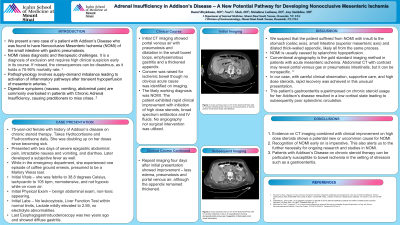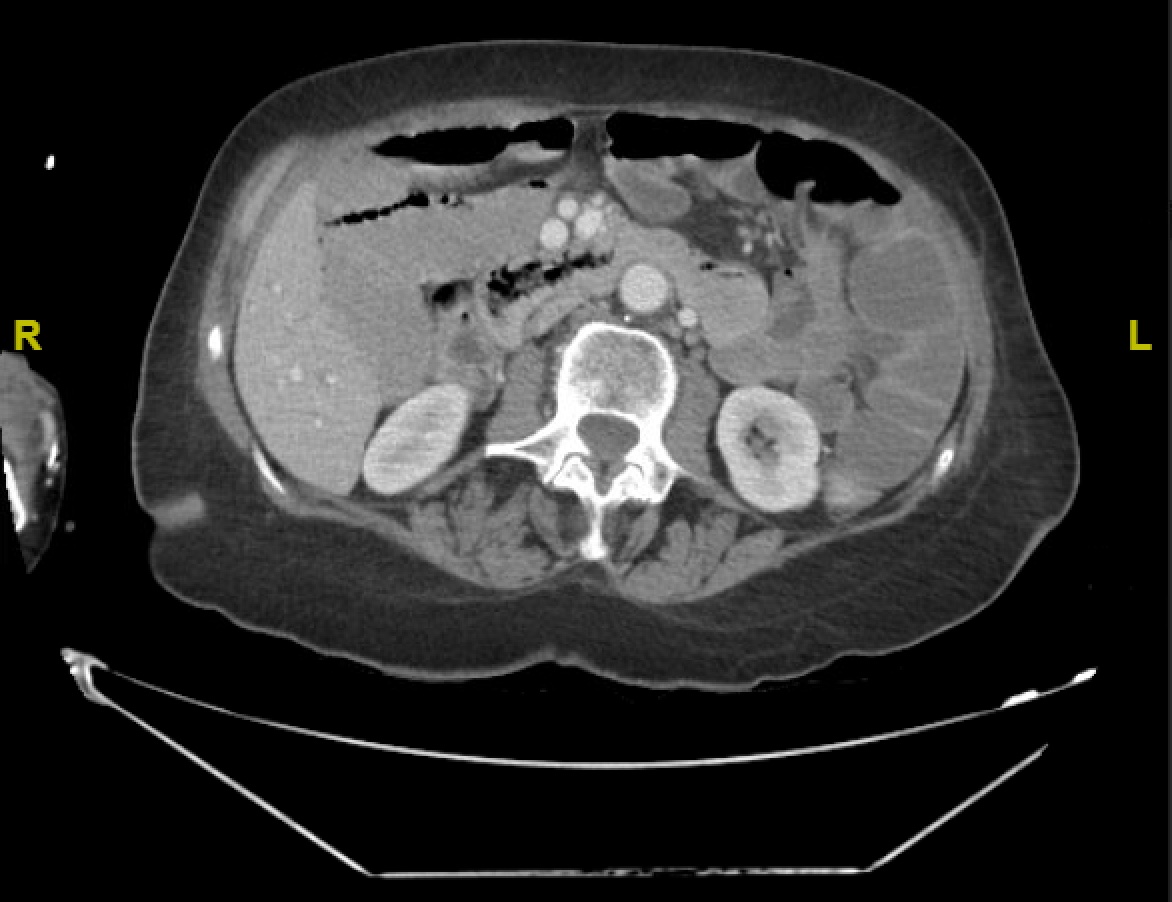Tuesday Poster Session
Category: Small Intestine
P4998 - Adrenal Insufficiency in Addison's Disease - A New Potential Pathway for Developing Nonocclusive Mesenteric Ischemia
Tuesday, October 29, 2024
10:30 AM - 4:00 PM ET
Location: Exhibit Hall E

Has Audio

Daniel Bleykhman, MD
Mount Sinai South Nassau, Icahn School of Medicine at Mount Sinai
Oceanside, NY
Presenting Author(s)
Daniel Bleykhman, MD1, Neal Shah, DO1, Muhddesa Lakhana, DO1, Amy Smithline, MD2
1Mount Sinai South Nassau, Icahn School of Medicine at Mount Sinai, Oceanside, NY; 2Mount Sinai South Nassau Hospital, Oceanside, NY
Introduction: We present a rare case of a patient with Addison’s disease who was found to have Nonocclusive Mesenteric Ischemia (NOMI), with a rapid recovery despite minimal invasive intervention. NOMI is a diagnosis of exclusion and requires high clinical suspicion early in its course. If missed, the consequences can be disastrous, as it holds a 70-90% mortality rate. In this case, less invasive imaging and interventions were utilized compared to normally recommended practices for NOMI. Serial CT imaging and clinic observation confirmed resolution of the disease. We show how our understanding of possible causes of NOMI may need to expand further.
Case Description/Methods: Our patient was a 75-year-old female with history of Addison’s disease on chronic steroid therapy, who presented with two days of abdominal pain, nausea, vomiting, and diarrhea. While in the emergency department, she experienced one episode of coffee ground emesis and was febrile to 38.8 degrees Celsius while hemodynamically stable. Initial CT imaging showed portal venous air with pneumatosis and dilatation in the small bowel loops, emphysematous gastritis and a thickened appendix. Concern was raised for ischemic bowel though no obvious acute cause was identified on imaging. The likely working diagnosis was NOMI. The patient exhibited rapid clinical improvement with initiation of stress dose steroids, broad spectrum antibiotics and IV fluids. No angiography nor surgical intervention was utilized. Repeat imaging four days after initial presentation showed improvement – less edema, pneumatosis and portal venous air, although the appendix remained thickened.
Discussion: We suspect that the patient suffered from NOMI with insult to the stomach (celiac axis), small Intestine (superior mesenteric axis) and dilated thick-walled appendix, likely all from the same process. With careful clinical observation, supportive care, and high dose steroids, rapid recovery was achieved in this unusual presentation. This patient’s gastroenteritis superimposed on chronic steroid usage for her Addison’s disease resulted in a low cortisol state leading to activation of the sympathetic pathways and subsequent poor circulation. Evidence on imaging combined with clinical improvement on high dose steroids shows a potential new or uncommon cause for NOMI. Recognition early on is imperative. This also alerts us to the further necessity for ongoing research and studies in NOMI.

Disclosures:
Daniel Bleykhman, MD1, Neal Shah, DO1, Muhddesa Lakhana, DO1, Amy Smithline, MD2. P4998 - Adrenal Insufficiency in Addison's Disease - A New Potential Pathway for Developing Nonocclusive Mesenteric Ischemia, ACG 2024 Annual Scientific Meeting Abstracts. Philadelphia, PA: American College of Gastroenterology.
1Mount Sinai South Nassau, Icahn School of Medicine at Mount Sinai, Oceanside, NY; 2Mount Sinai South Nassau Hospital, Oceanside, NY
Introduction: We present a rare case of a patient with Addison’s disease who was found to have Nonocclusive Mesenteric Ischemia (NOMI), with a rapid recovery despite minimal invasive intervention. NOMI is a diagnosis of exclusion and requires high clinical suspicion early in its course. If missed, the consequences can be disastrous, as it holds a 70-90% mortality rate. In this case, less invasive imaging and interventions were utilized compared to normally recommended practices for NOMI. Serial CT imaging and clinic observation confirmed resolution of the disease. We show how our understanding of possible causes of NOMI may need to expand further.
Case Description/Methods: Our patient was a 75-year-old female with history of Addison’s disease on chronic steroid therapy, who presented with two days of abdominal pain, nausea, vomiting, and diarrhea. While in the emergency department, she experienced one episode of coffee ground emesis and was febrile to 38.8 degrees Celsius while hemodynamically stable. Initial CT imaging showed portal venous air with pneumatosis and dilatation in the small bowel loops, emphysematous gastritis and a thickened appendix. Concern was raised for ischemic bowel though no obvious acute cause was identified on imaging. The likely working diagnosis was NOMI. The patient exhibited rapid clinical improvement with initiation of stress dose steroids, broad spectrum antibiotics and IV fluids. No angiography nor surgical intervention was utilized. Repeat imaging four days after initial presentation showed improvement – less edema, pneumatosis and portal venous air, although the appendix remained thickened.
Discussion: We suspect that the patient suffered from NOMI with insult to the stomach (celiac axis), small Intestine (superior mesenteric axis) and dilated thick-walled appendix, likely all from the same process. With careful clinical observation, supportive care, and high dose steroids, rapid recovery was achieved in this unusual presentation. This patient’s gastroenteritis superimposed on chronic steroid usage for her Addison’s disease resulted in a low cortisol state leading to activation of the sympathetic pathways and subsequent poor circulation. Evidence on imaging combined with clinical improvement on high dose steroids shows a potential new or uncommon cause for NOMI. Recognition early on is imperative. This also alerts us to the further necessity for ongoing research and studies in NOMI.

Figure: Cross sectional view on CT of the Abdomen/Pelvis with IV Contrast showing portal venous air and pneumatosis in several anterior small bowel loops with dilatation.
Disclosures:
Daniel Bleykhman indicated no relevant financial relationships.
Neal Shah indicated no relevant financial relationships.
Muhddesa Lakhana indicated no relevant financial relationships.
Amy Smithline indicated no relevant financial relationships.
Daniel Bleykhman, MD1, Neal Shah, DO1, Muhddesa Lakhana, DO1, Amy Smithline, MD2. P4998 - Adrenal Insufficiency in Addison's Disease - A New Potential Pathway for Developing Nonocclusive Mesenteric Ischemia, ACG 2024 Annual Scientific Meeting Abstracts. Philadelphia, PA: American College of Gastroenterology.
